Do’s and dont’s for teaching phonemic awareness
Looking for tips for teaching phonemic awareness?
In this post I’ll share do’s and don’ts for teaching phonemic awareness … sharing mistakes I’ve made in the past and new insights I’ve gained through my study of the science of reading.
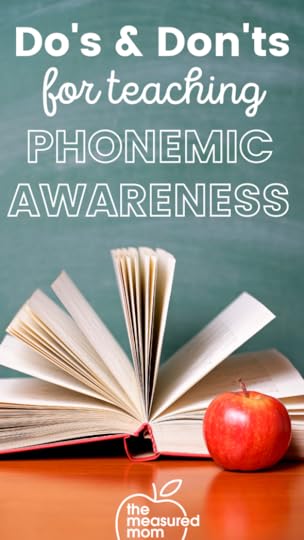
As we consider do’s and don’ts for teaching phonemic awareness skills, let’s start with the basics.
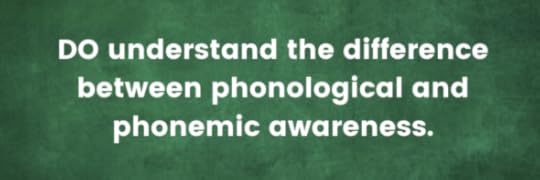
I admit it … I didn’t understand the difference between phonological and phonemic awareness for a long time.
I knew they weren’t the same as phonics. I knew that phonics has to do with print, and phonological/phonemic awareness has to do with sounds.
But the rest was fuzzy.
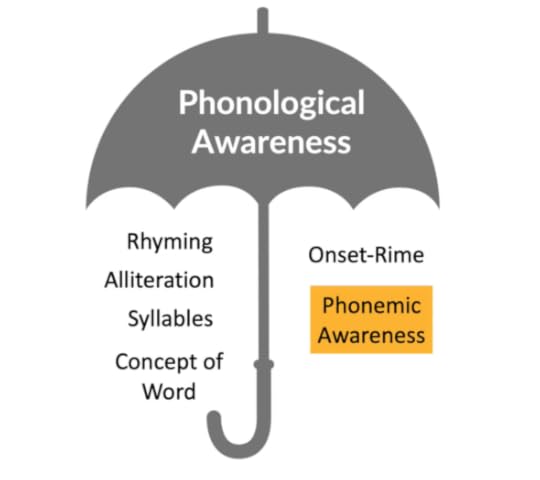
A visual helps.
The above graphic is from my online course, Teaching Every Reader. As you can see, there are many components of phonological awareness: rhyming, alliteration, syllables, concept of word, onset- rime, AND phonemic awareness.
Phonemic awareness is just one piece of phonological awareness.
Many researchers would argue that it’s the most important piece.
There are several mental skills associated with word reading. Phoneme awareness appears to be one of the most important of these skills. Phoneme awareness refers to the ability to notice that spoken words can be broken down into smaller parts called phonemes.
David Kilpatrick, Equipped for Reading Success
Did you catch that?
While the other components of phonological awareness have to do with the larger parts of words (syllables, onset/rime, etc.), a phoneme is the smallest part of a word. It’s an individual sound.
Test yourself.
How many phonemes does each of these words have?
hatfishswimboxsquishReady for the answer key? Note … when you see letters between those slash marks (fancy word = virgules), we are referring to the sounds, not the letter names.
Hat has three phonemes: /h/ /a/ /t/Fish has three phonemes: /f/ /i/ /sh/Swim has four phonemes: /s/ /w/ /i/ /m/Fox has four phonemes: /b/ /o/ /k/ /s/Squish has five phonemes: /s/ /k/ /w/ /i/ /sh/How’d you do?
If you’re new to counting phonemes, don’t worry! It takes a little practice.
Before we move on, let’s remember that there are four levels of phonemic awareness.The following infographic breaks down the four types and gives a sample phonemic awareness task for each one.

If you’re asking, “Who cares?” then I say “Great question.”
Knowing what phonemic awareness is does us no good if we don’t understand why it matters.
That brings us to our second “do …”

Let’s start with the end goal: reading comprehension.
How do we get there?
Check out this quote from David Kilpatrick.
Reading comprehension is our goal, and the most direct route to good reading comprehension is to make the word recognition process automatic so a student can focus all of his or her mental energy on the meaning.
David Kilpatrick, Equipped for Reading Success
The next logical question is: HOW do we make the word recognition process automatic? How do we get students to the place where they recognize words immediately without needing to sound them out?
Hint: It’s not through memorizing long lists of words!
We use a process called orthographic mapping to be able to instantly recognize words.
Orthographic mapping is a process by which we map phonemes to graphemes.
Say what?!
This threw me for a loop for while, but it’s not as complex as it sounds.
Phonemes = sounds
Graphemes = printed letters which represent sounds
Therefore, orthographic mapping is a mental process by which we match the sounds of a word to the letters in a word (the spellings). By second grade, typical readers need just 2-4 exposures to a word to have it “orthographically mapped.”
We cannot become good at orthographic mapping unless we have both letter sound knowledge AND PHONEMIC AWARENESS.
(That was a very quick look at orthographic mapping, and if you don’t quite get it yet, that’s normal. Here’s an 11-minute video from Ms. Jane’s Tutoring & Dyslexia Services that explains it in an easy-to-understand way.

Once we understand WHAT phonemic awareness is, and WHY we need to teach it, we’re ready to get started.
But before you start, make sure you know how to pronounce phonemes properly.
What’s the sound of the letter l?
Did you say “luh”? Many people make that mistake.
Instead, we say that the sound of letter l is /llllll/.
Otherwise, if students are sounding out the word let, they might read it as luh-et.
Pronouncing phonemes getseven trickier with letters like p and b. It’s hard to clip the sounds quickly so we don’t add an “uh” to the end.
Check out this quick video to make sure you’re pronouncing all 44 phonemes correctly (the sounds will be different, of course, if you are not speaking American English.)
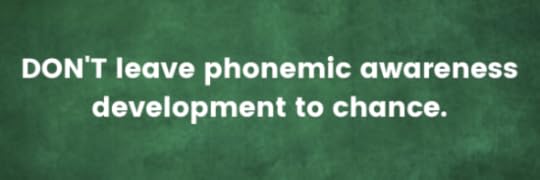
I have to hang my head in shame here because, for years, I didn’t give a lot of thought to phonemic awareness.
By “years” I mean all the years I was a classroom teacher. UGH.
I thought that the playful games we played with words and songs would be enough.
And it was … for some students.
I didn’t get that phonemic awareness is often the missing key for struggling readers. (And truthfully, all my students would have benefited from explicit instruction in phonemic awareness.)
Had I known its importance, I would have made it a point to teach phonemic awareness every day. (Every kindergarten and first grade teaches should fit it into their daily schedule.)
The good news is that phonemic awareness instruction doesn’t have to take long, and it requires few materials.
Many teachers love the Heggerty phonemic awareness curriculum. The program includes hand motions and daily lessons that take just 10-15 minutes.
I think Heggerty is a pretty solid program, but if your budget is tight, you can get a free printable phonemic awareness program at Reading Done Right.
Not ready to purchase a full curriculum? My phonemic awareness bundle has 12 weeks of oral phonemic awareness activities, plus printable games kids love.
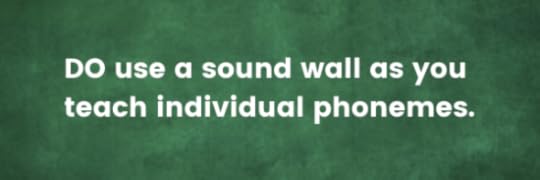
Are you familiar with sound walls? They’re all the rage these days – a substitute for the more traditional word walls.
In the past, we used word walls as a way to help kids find spellings of high frequency words.
But the problem with a word wall is that while we have 44 phonemes in the English language, a word wall only has 26 letters.
It makes more sense to teach children sounds (phonemes) and then gradually add words to the sound wall as they learn phonics patterns that spell those sounds.

Here’s a sound wall that I helped a teacher put up this very morning. (This is my own creation and will be added to my shop in the next few months.)
I won’t get into all the specifics here, but you can see that the sounds are arranged based on how they’re made in the mouth.

We falso put up this sound wall for vowel phonemes. You can see that the vowels are arranged based on how your mouth is formed when you make the sounds. The bottom-most sound is the short o, when your mouth is opened the widest.
Many teachers have little mirrors that they give their students so they can see how their mouth looks when they articulate particular phonemes.
Here’s a very important sound wall tip …
Do not put up all the sounds and word cards on the first day!
The above examples are complete sound walls that you might not even see until third grade.
You should only display the words below each sound when you’ve taught that phonics pattern.
For example, the above sound wall includes “ei” for veil. You would likely not teach that pattern in first grade, so a first grade teacher would never use that card.
(If the idea of sound walls is fuzzy, stay tuned, because my upcoming product will explain exactly how to use it!)
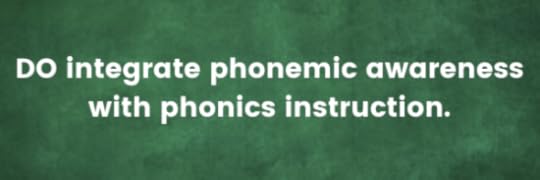
We often hear that phonemic awareness activities can be done in the dark (without print), and that’s true, but it’s also important to teach phonemic awareness and phonics together.
One of my favorite ways to do that is with phoneme grapheme mapping. Check out this video I did with my preschool-aged son and our neighbor. (They are little; please excuse the incorrect letter formation.  )
)
In this activity they practiced:
Phoneme segmentingPhoneme blendingWe could have added phoneme isolation by asking, “What’s the first/middle/last sound?”
We could have added phoneme manipulation by asking, “If you took the /s/ off of sun and replaced it with /f/, what would the new word be?”
Another way to integrate phonemic awareness with phonics is to have a phonemic awareness warm-up related to the phonics skill you’re about to teach.
For example: If you’re teaching the ai spelling pattern, tell your students to listen for the vowel sound in each word. They should give a thumbs up if they hear the long a sound.
bat (thumbs down)
rain (thumbs up)
say (thumbs up)
snack (thumbs down)
weigh (thumbs up)
Then continue on to your phonics lesson in which you tell them that ai is one way to represent the long a sound.
Let’s sum up!This was a hefty blog post about teaching phonemic awareness! Let’s review.
DO understand the difference between phonological and phonemic awareness. Phonemic awareness has to do with the individual sounds in words. There are four kids of phonemic awareness tasks:
phoneme isolationphoneme blendingphoneme segmentingphoneme manipulationDO understand the importance of phonemic awareness. The short explanation is that students must be proficient in phonemic awareness to be able to do the mental process of orthographic mapping – which is how we recognize words automatically instead of having to sound them out.
DON’T leave phonemic awareness to chance. Kindergarten and first grade teachers should reserve 5-10 minutes for phonemic awareness instruction every day.
DO use a sound wall as you teach each phoneme. Remember not to add a word card until you’ve taught the phonics pattern associated with that word.
Finally, DO integrate phonemic awareness with phonics instruction. You can do that with activities like phoneme grapheme mapping or by doing a related phonemic awareness task before you teach a new phonics skill.
As a reward for making it to the end of this post, you’re invited to download this FREE set of phonemic awareness games, a sample from my full set.
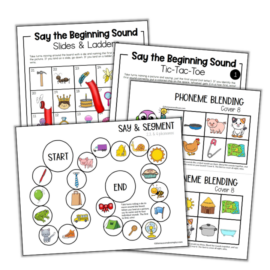
Free phonemic awareness games
CLICK TO DOWNLOAD
The rest of this series is coming this Fall!
Part 1 Part 2 – Coming August 30 Part 3 – Coming September 6 Part 4 – Coming September 13 Part 5 – Coming September 20
The post Do’s and dont’s for teaching phonemic awareness appeared first on The Measured Mom.
Anna Geiger's Blog
- Anna Geiger's profile
- 1 follower



